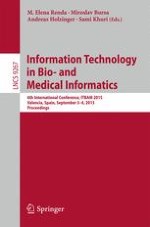2015 | Buch
Information Technology in Bio- and Medical Informatics
6th International Conference, ITBAM 2015, Valencia, Spain, September 3-4, 2015, Proceedings
herausgegeben von: M. Elena Renda, Miroslav Bursa, Andreas Holzinger, Sami Khuri
Verlag: Springer International Publishing
Buchreihe : Lecture Notes in Computer Science
